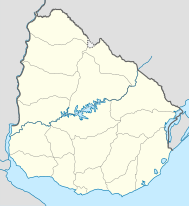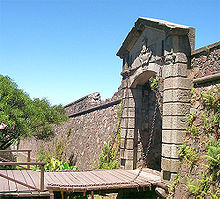Colonia del Sacramento
| Colonia del Sacramento | ||
|---|---|---|
|
Coordinates: 34 ° 28 ′ S , 57 ° 51 ′ W Colonia del Sacramento on the map of Uruguay
|
||
| Basic data | ||
| Country |
|
|
| Department | Colonia | |
| City foundation | 1680 by Manuel Lobo | |
| Residents | 26,231 (2011) | |
| City insignia | ||
| Detailed data | ||
| height | 23 m | |
| Post Code | 70000 | |
| prefix | +052 | |
| City Presidency | Alfredo Martínez Izquierdo | |
| Website | ||
| The Colonia del Sacramento lighthouse | ||
Colonia del Sacramento is a small town on the Río de la Plata in Uruguay .
It is the capital of the Colonia department . Colonia del Sacramento is the oldest city in Uruguay , its old town has been declared a World Heritage Site by UNESCO .
history
Colonia del Sacramento was founded in the last days of January 1680 by Dom Manuel Lobo , Governor of Rio de Janeiro , on behalf of the Prince Regent Pedro II of Portugal. Pedro II wanted to build a bridgehead on the coast of the Río de la Plata to defend his empire.
On January 20, 1680, Don Lobo arrived by ship on the island of San Gabriel off the Colonia del Sacramento and occupied the strategic point that was important for the Portuguese Empire. First, a church and fort were built on the mainland. The Spanish government in Buenos Aires, under the command of Don José de Garro , attacked and occupied the fort in Colonia del Sacramento.
On May 7, 1681 "por el Tratado Provisional de Lisboa" Colonia del Sacramento was returned to the Portuguese. From 1705 to 1715 Colonia del Sacramento was named No Man's Land and was under the command of Governor Alonso de Valdés Inclán in Buenos Aires.
On April 11, 1713, the Treaty of Utrecht was signed and Spanish influence in South America was dramatically reduced. On November 4, 1715, Governor Manuel Goméz Barboza was installed by the Spanish provincial government in Buenos Aires and ruled until 1722. In 1718, Colonia del Sacramento had 1,400 inhabitants, including slaves and Indians.
On March 14, 1722, the Portuguese governor Vasconcellos took control of the city and a lively hustle and bustle developed. Colonia del Sacramento flourished and culture and trade expanded. In January 1730, the first theater was built on Uruguayan soil and inaugurated with the first performance of Las Armas De La Hermosura by Pedro Calderón de la Barca .
In 1735 the city was again occupied by Spanish troops and the governor Pedro de Vasconcellos was deposed on September 16, 1737. The port of Colonia del Sacramento was expanded and thus acquired a key position in trade with the surrounding states in South America.
During Pedro de Vasconcellos ' term of office there were sometimes up to 50 ships under different flags in the port of Colonia, transporting contraband goods to the Viceroyalty of Peru .
In 1756 the Seven Years War between Portugal and Spain began and in 1762 Colonia del Sacramento was attacked again by the Spanish general Pedro de Cevallos . Days later, British warships bombed from the Río de la Plata off Colonia. The English frigate "Lord Clive" was sunk in a counterattack.
In the Treaty of Paris on January 13, 1763, Colonia came back into Portuguese hands and remained there until 1777. The city was rebuilt.
On October 1, 1777, the rights of the Portuguese were ceded to the Spaniards. On March 5, 1807, the English occupied the city until the end of August. During this time, the Uruguayan national hero José Gervasio Artigas came to power with like-minded people and in the Revolución del Mayo this group took command until February 2, 1811.
From 1822 to 1826 Portugal was again ruler, but the Argentine army attacked the city again under the leadership of General Almirante Brown . On December 2, 1828 Colonia was handed over to the Fuerzas Orientales on the basis of the Convención Preliminar de la Paz treaty . The support of the English, the transport of slaves and smuggled goods gave the city a privileged position.
In 1845, during the Guerra Grande by José Garibaldi , Colonia and Isla Martin Garcia were occupied. In 1848 Colonia was attacked by Manuel Oribe (2nd President of Uruguay) with his troops and the political directions were determined. In the area of Colonias, the Banda Oriental was formed , which later split into the first parties of Uruguay, the Blancas y Coloradas, which often formed the government.
By decree no. 618 of October 10, 1968, the state decided to preserve and largely restore the colonial old town center.
In December 1995 the old town of Colonia del Sacramento was declared a World Heritage Site by UNESCO.
Infrastructure
education
Colonia has two secondary schools ( Liceo ). These are the Liceo Nº 1 Departamental “Prof. Juan L. Perrou ” and the Liceo Nº 2 Real de San Carlos, which has existed since 2004 .
Culture and sights
Colonia is home to several museums. These are the Portuguese Museum, the Spanish Museum, the Museum of Colonial Tiles (azulejos) with the map of the city of Colonia from 1762 and the Museum of the Aborigines of the Region (Indians).
Other sights and important buildings in Colonia are:
- the old city gate
- the old bastion (fort)
- the old lighthouse, the construction of which began in 1845 and was not completed until 1857, interrupted by the Guerra Grande .
- the ruins of the monastery of San Francisco Xavier
- the regional archive
- the Church of the Basilica of the Blessed Sacrament (Basilica del Santísimo Sacramento)
- the old house of the commander of C. Brigadier General Juan Antonio Lavalleja
- an originally preserved house (Casa de Nacarello or more popularly Casa Rosada) from the time of the Portuguese from 1750
- la Calle de los Suspiros with beautifully restored old houses
- the small church "Iglesia de Benito" from 1761
- the bullring "Plaza de Toros"; the first bullfight was on January 9, 1910
Sports
With the Estadio Suppici, Colonia has a stadium with a capacity of 12,000, in which the football club Plaza Colonia plays its home games. In the 2011/12 season, the club will play in Uruguay's second-highest division, the Segunda División .
traffic
Colonia del Sacramento is 177 kilometers west of the capital, Montevideo , and numerous buses run on the coastal road between the two cities. The port is also important to Colonia as it is the closest Uruguayan city to Buenos Aires . Several ferries a day connect the two cities. Since the direct connection from Montevideo to Buenos Aires is much more expensive, many people make the detour via Colonia del Sacramento to save money and visit the historic old town before continuing. There are plans for a bridge over the wide estuary delta Río de la Plata , which would connect the city with Buenos Aires, but do not seem to be realized in the near future. In addition, Colonia del Sacramento has its own airport with the Aeropuerto Internacional de Laguna de los Patos .
Residents
In 2011 the city had 26,231 inhabitants, of which 12,643 were men and 13,588 were women.
| year | Residents |
|---|---|
| 1963 | 13,337 |
| 1975 | 17,046 |
| 1985 | 19.102 |
| 1996 | 22,200 |
| 2004 | 21,714 |
| 2011 | 26,231 |
sons and daughters of the town
- Juan Carlos Arellano (born 1943), artist
- Enrique Ballestrero (1905-1969), football player
- José Batista (born 1962), football player
- Mariano Bogliacino (* 1980), football player
- Facundo Boné (* 1995), football player
- Ezequiel Casaña (* 1992), football player
- Fernando Cardani (* 1940), actor and theater director
- Octavio Colo (* 1994), football player
- Santiago de Ávila (* 1993), football player
- Emiliano Dumestre (* 1987), rower
- Eduardo García (1945–2016), football player and coach
- Edgardo González (1936–2007), football player
- Julián Gottesman (* 1994), football player
- Facundo Kidd (born 1997), soccer player
- Federico Puppo (* 1986), soccer player
- Gabriel Pérez (* 1995), football player
- Rodrigo Rivero (born 1995), football player
- Horacio Salaberry (* 1987), football player
- Leandro Salvagno (* 1984), rower
- Francisco Vega (* 1989), football player
- Cristian Villoldo (* 1985), football player
- Facundo Waller (* 1997), football player
In the summer of 2005, the guitarist Matthias "Gonzo" Röhr , a member of the German rock band Böhse Onkelz , emigrated to Colonia del Sacramento.
Web links
- 360 ° Virtual Tours in Colonia - Uruguay360.com.uy
- official page
- Colonia del Sacramento information pages and other links
- Colonia del Sacramento
- Description of the city (Spanish), some photos and other links
- Film and photos about the city in the series "Treasures of the World"
- Unesco World Heritage Site on Colonia del Sacramento
- Entry on the UNESCO World Heritage Center website ( English and French ).
Individual evidence
- ^ Contributions to the urban geography of Montevideo . Edited by Günter Mertins, 1987, p. 157.
- ↑ Liceos del Uruguay (Spanish; PDF; 6.94 MB), accessed on February 29, 2012
- ↑ Russ Rowlett: Lighthouses of Uruguay ( English ) In: The Lighthouse Directory . University of North Carolina at Chapel Hill . Retrieved September 17, 2011.
- ↑ Statistical data from the Instituto Nacional de Estadística de Uruguay , accessed on October 3, 2012
- ↑ Statistical data of the Instituto Nacional de Estadística de Uruguay 1963–1996 (DOC file; 172 kB)
- ↑ Statistical data of the Instituto Nacional de Estadística de Uruguay 2004 (PDF; 482 kB)
- ↑ Gonzo: The official and authorized biography of Matthias Röhr . Autobiography written with co-authors Dennis Diel and Marco Matthes, Hannibal Verlag , Höfen , 1st edition, November 2019. p. 314





